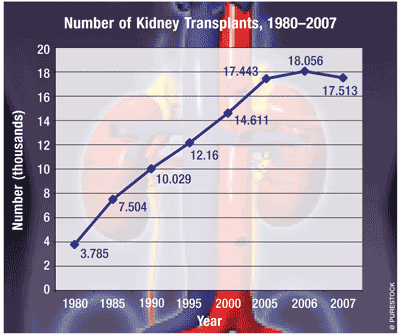US Pharm. 2011;36(6):56.
National Health and Nutrition Examination Survey (NHANES) data show that 23 million adults (11.5%) suffered from chronic kidney disease (CKD) in 2004. While CKD was more common in women, men with CKD were 50% more likely to progress to kidney failure. In 2007, more than 500,000 Americans underwent treatment for end-stage renal disease (ESRD), at a cost of $35.32 billion in public and private spending. Also in 2007, an additional 111,000 patients initiated treatment for ESRD. The National Institutes of Health has estimated that 2 million ESRD patients will receive treatment by 2030.

Comorbidity as Risk Factor: While risk factors for CKD include diabetes, hypertension, family history of kidney failure, and cardiovascular disease, diabetes and hypertension accounted for 69% of new cases of CKD. Based on NHANES data, the top five diseases that primarily caused ESRD were diabetes (37%), hypertension (24%), glomerulonephritis (16%), cystic kidney (5%), and urologic disorders (3%). Between 2000 and 2007, the incidence of ESRD due to diabetes increased by less than 1% and the incidence of glomerulonephritis fell by 21%, suggesting a possible improvement in the clinical management of diabetes. In contrast, the incidence of ESRD caused by hypertension increased by 8% between 2000 and 2007.
Ethnicity as Risk Factor: Compared with white individuals, the risk of CKD was 3.8, 2.0, 1.5, and 1.3 in African American, Native American, Hispanic, and Asian individuals, respectively. Diabetes was the primary cause of CKD among African Americans; the second highest cause was high blood pressure.
Dialysis: In 2004, 335,000 individuals were on dialysis. This is three times the number of patients who were on dialysis in 1988. In the clinic setting, 91% (i.e., 338,265) of ESRD dialysis patients received hemodialysis and 7% (i.e., 26,364) were given peritoneal dialysis; less than 1% of patients received dialysis at home.
Kidney Transplants: The number of kidney transplants increased exponentially from 1980 to 2005, after which the rate stabilized. In 2010, 83,950 patients were waiting to receive a kidney and 2,208 patients were waiting to receive a kidney and a pancreas. Among the factors responsible for the increased waiting list was the pool of donors. In 2007, 67% of kidneys came from deceased donors, 19% from living related donors, 8% from living unrelated donors, and 5% from spouses or life partners. According to NHANES data, 5-year patient survival following a deceased-donor transplant was more than 80%, but a transplant from a living donor increased the probability to more than 90%. For both types of donor organs, however, the probability of 10-year survival dropped substantially over time (deceased-donor organ, 61%; living-donor organ, 76%).
To comment on this article, contact rdavidson@uspharmacist.com.






